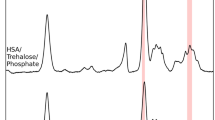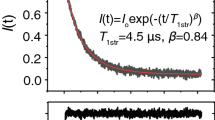Abstract—Spin labeling EPR spectroscopy was used to study the structural and conformational characteristics of human serum albumin and human erythrocyte membranes under normal conditions and with symptoms of heart failure. 5-Doxyl stearic acid and 16-doxyl stearic acid were used as spin labels, whose paramagnetic NO fragments are bound to different sites of the hydrocarbon chain. The EPR spectra of 16-doxyl stearic acid indicate that in the physiological temperature range serum albumin molecules are characterized by several types of fatty acid binding sites, which differ in parameters of spin-label rotational diffusion. This distribution of fatty-acid binding sites was typical for the blood serum of all patients who participated in our study, regardless of deviations from the normal blood parameters. The microviscosity of erythrocyte membranes from patient blood was measured using both 5-doxyl stearic and 16-doxyl stearic spin labels, whose paramagnetic fragments are located at different depths inside the lipid bilayer. It was found that in patients with an increased erythrocyte distribution width, the membrane lipid microviscosity is statistically significantly higher than under normal conditions.






Similar content being viewed by others
REFERENCES
N. N. Pshenkina, Farmakologiya 12, 1067 (2011).
J. R. Simard, Anal. Biochem. 347, 97 (2006).
A A. Pavićević, A. D. Popović-Bijelić, M. D. Mojović, et al., J. Phys. Chem. 118, 10898 (2014).
S. C. Kazmierczak, A. Gurachevsky, G. Matthes, et al., Clin. Chem. 52, 2131 (2006).
A. Gurachevsky, E. Muravskaya, T. Gurachevskaya, et al., Cancer Invest. 25 (6), 378 (2007).
Yu. M. Petrusevich, O. P. Revokatov, and A. N. Ti-khonov, USSR Inventor’s Certificate No. 1319705 (1984).
M. Moergel, P. W. Kammerer, K. Schnurr, et al., Clin. Oral Invest. 16, 1529 (2012).
Y. Akdogan, M. Emrullahoglu, D. Tatlidil, et al., Phys. Chem. Chem. Phys. 18, 22531 (2016).
A. Gurachevsky, E. Shimanovitch, T. Gurachevskaya, et al., Biochem. Biophys. Res. Commun. 360, 852 (2007).
M. Gelos, D. Hinderberger, E. Welsing, et al., Int. J. Colorectal Dis. 25, 119 (2010).
V. V. Moroz, A. M. Golubev, A. V. Afanas’ev, et al., Obshch. Reanimatol. 8, 1 (2012).
M. Minetti, J. Cell. Biochem. 25, 73 (1984).
P. S. C. Prete, C. C. Domingues, N. C. Meirelles, et al., Biochim. Biophys. Acta 1808 (1), 164 (2011).
M. Montagnana, G. Cervellin, T. Meschi, et al., Clin. Chem. Lab. Med. 50, 635 (2011).
E. Danese, G. Lippi, and M. Montagnana, J. Thoracic Disease 7, 402 (2015).
K. Tsuda, Int. Heart J. 54, 154 (2013).
E. K. Ruuge, E. A. Noeva., T. Sh. Sharifov, et al., Eur. Heart J. 16 (Suppl.), 473 (1995).
H. M. McConnell and B. G. McFarland, Quart. Rev. Biophys. 3, 91 (1970).
B. J. Gaffney and H. M. McConnell, J. Magn. Reson. 16, 1 (1974).
M. A. Hemminga, Chem. Phys. Lipids 32, 323 (1983).
T. Pohl, T. Spatzal, M. Aksoyoglu, et al., Biochim. Biophys. Acta 1797, 1894 (2010).
Funding
This work was supported by the Russian Foundation for Basic Research, project no. 18-015-00125.
Author information
Authors and Affiliations
Corresponding author
Ethics declarations
Conflict of interests. The authors declare that they have no conflict of interest.
Statement of compliance with standards of research involving humans as subjects. All procedures performed in studies involving human participants were in accordance with the 1964 Helsinki Declaration and its later amendments or comparable ethical standards. Informed consent was obtained from all individual participants involved in the study.
Additional information
Translated by I. Shipounova
Abbreviations: 5DS, 5-doxyl stearic acid; 16DS, 16-doxyl stearic acid.
Rights and permissions
About this article
Cite this article
Grachev, D.I., Dudylina, A.L., Titov, V.N. et al. The Physicochemical Characteristics of Serum Albumin and Erythrocyte Cell Membranes under Normal and Heart Failure Symptom Conditions. BIOPHYSICS 64, 721–728 (2019). https://doi.org/10.1134/S0006350919050051
Received:
Revised:
Accepted:
Published:
Issue Date:
DOI: https://doi.org/10.1134/S0006350919050051




